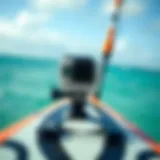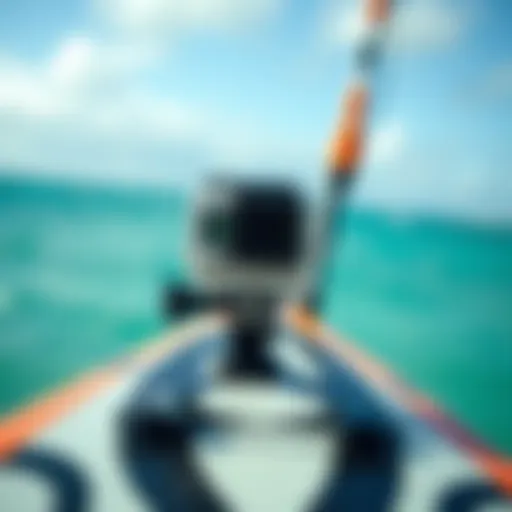Explore the Coiled Surf Leash: Essential Insights


Intro
In the velvety embrace of the ocean, kiteboarders dance with the wind and waves, each moment marked by the thrill of balance and freedom. One might think, what’s the key to this exquisite balance? Among the myriad of equipment, the coiled surf leash holds its ground as an unsung hero. As kiteboarders lean into new challenges, understanding the nuances of gear, particularly the surf leash, becomes crucial. This versatile accessory not only plays a role in safety but also enriches performance, transforming what could be a tense ride into a seamless experience.
While the coiled surf leash comes with its share of intricacies, unraveling these details leads to better choices for riders of all skill levels. From the materials that fortify its design to maintenance practices that prolong its life, this guide aims to dissect these components thoroughly. It’s about more than just buying a leash; it’s about investing in an essential part of your kiteboarding adventure.
In this exploration, you’ll encounter key insights into selecting the right gear, honing essential techniques, and navigating the evolving trends in surf leashes. This isn’t just a conversation about hardware—it’s a dialogue about the experience of kiteboarding itself. Let’s dive into the heart of the matter, starting with gear selection.
Foreword to the Coiled Surf Leash
The coiled surf leash is not just another accessory; it plays a pivotal role in the realm of kiteboarding. While riding the waves, the last thing any kiteboarder wants is to lose their board to the turbulent sea. This is where the importance of the coiled surf leash comes to light. With its unique design and functionality, it not only enhances rider safety but also improves overall performance on the water. Understanding its nuances can help enthusiasts, instructors, and event organizers alike, gear up the right way for an exciting adventure.
Definition and Purpose
A coiled surf leash is essentially a tether between the rider and their board, designed to prevent the board from floating away after a fall. What sets it apart from traditional straight leashes is its coiled design, which minimizes drag and tangling while riding. Typically made from elastic materials, when a rider falls, the leash retracts without getting in the way of their movements. This means that riders can focus on their techniques instead of worrying about chasing after their gear. Additionally, it serves as a critical safety feature; should a rider get separated from their board in rough conditions, the leash ensures the board remains nearby, reducing the risk of injuries or collisions with other surfers.
History and Evolution
The journey of the surf leash, particularly the coiled variation, has evolved significantly over the years. Initially, surf leashes were simple lengths of rope or cord, often causing drag and limiting maneuvers. As sports technology advanced, so did the materials and engineering behind leashes. The coiled surf leash emerged as a response to common issues faced by riders, like tangling and reduced performance. The introduction of elastic materials transformed how riders interact with their boards. With enhanced elasticity, brands started to craft leashes that could stretch and retract, paving the way for a safer and more dynamic riding experience. Nowadays, these leashes continue to improve with the innovation of eco-friendly materials and advanced designs, catering to an ever-growing market of kiteboarders who seek both performance and sustainability.
Understanding this history not only provides context but also appreciation for the evolution of the coiled surf leash. It underscores the importance of choosing the right gear for safe and enjoyable riding, ensuring every kiteboarding session is both exhilarating and secure.
Design Elements of Coiled Surf Leashes
Delving into the design elements of coiled surf leashes provides insight into why they have become the go-to choice for many kiteboarders. Understanding specific aspects, from the materials used to the coiling mechanism itself, can significantly influence a rider's choice and overall experience on the water. With every element meticulously crafted, these leashes embody a balance of safety, functionality, and performance.
Material Composition
Nylon vs. Polyester
When looking at options like nylon and polyester, both materials come with their unique traits that stand out in the context of surf leashes. Nylon is often appreciated for its strength and flexibility, making it a robust option. This material's ability to stretch without losing structural integrity can provide a much-needed give during intense kiteboarding sessions. It also tends to be more resistant to abrasion, which is an asset when faced with the harshness of saltwater or sand.
Conversely, polyester is known for its excellent UV resistance, which can prolong the lifespan of the leash when exposed to sunlight for extended periods. This material resists fading and holds its shape well, making it increasingly popular. Despite its robust nature, polyester leashes might not have the same elasticity as their nylon counterparts.
Ultimately, the choice between nylon and polyester comes down to what the rider prioritizes. If one values flexibility and shock absorption, nylon could emerge as the preferable choice. However, if resistance to UV rays and shape retention is the priority, polyester holds its ground as a solid competitor.
Impact of Materials on Performance
The impact of materials on performance cannot be underplayed in discussions about coiled surf leashes. Each material interacts with environmental factors differently. For instance, a leash made from nylon may absorb the jerks and pulls of turbulent water far better than one crafted from less resilient materials. This ability ensures that riders experience fewer interruptions and can maintain their rhythm seamlessly, whether riding in rough sea conditions or performing stunts.
Moreover, the weight of the material should not be overlooked. A lighter leash reduces drag, which might enhance performance, allowing kiteboarders to glide more effortlessly across the water’s surface. In high-speed maneuvers, having a leash that doesn’t act as dead weight could be the difference between nailing that next trick or coming up short.
Coiling Mechanism
Understanding Elasticity
Elasticity is a crucial factor that defines a coiled surf leash’s function. The design's elasticity permits the leash to stretch and retract as the rider moves, providing an essential buffer against sudden pulls or jolts. This feature not only augments rider comfort but also enhances safety. If the kite pulls unexpectedly, an elastic leash can absorb some of that shock. The natural behavior of a coiled design allows the leash to simply recoil back, reducing the risk of injury to both the rider and others in close proximity.
In addition, the elasticity of these leashes promotes a more streamlined experience overall. Riders can enjoy the ocean without constantly flipping and tangling in their leashes, as the coiled design works to minimize this common frustration.
Advantages of Coiled Design
The advantages of a coiled design extend beyond just the aesthetics or how they look on the surfboard. The compactness that coiled leashes offer is mightily appealing. Since the leash curls up neatly, it reduces drag while riding, leading to improved performance and agility. Kiteboarders can focus on their moves rather than battling with a long, tangling leash.
Furthermore, with the coiled design, storage becomes a breeze when it comes time to pack up. No more wrestling with a straight leash that refuses to fit into a backpack or gear bag. The coiled style allows for easier, more organized packing, enabling riders to shift gears without fuss.
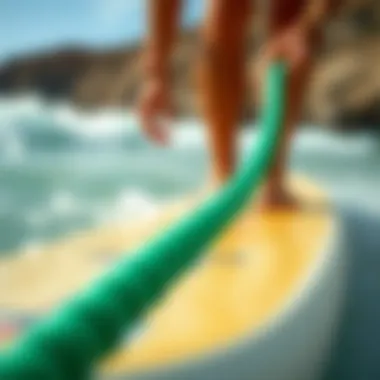
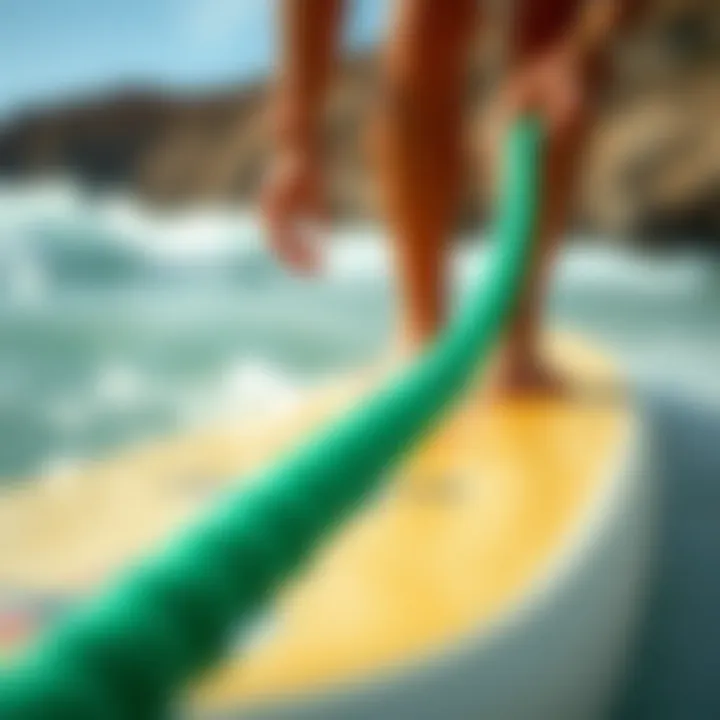
In summary, each design element in a coiled surf leash is intentionally crafted. Between material choices and the unique characteristics of the coiling mechanism, kiteboarders gain advantages that enhance their riding experience. Every aspect plays into the performance, safety, and convenience of kiteboarding, making an informed choice essential for all skill levels.
Advantages of a Coiled Surf Leash
The coiled surf leash represents more than just a link between you and your board. It embodies a strategic element of safety and performance enhancement that many riders may overlook. Understanding the advantages of a coiled surf leash is crucial for kiteboarders looking to improve their riding experience, regardless of skill level. Not only does it offer protection in various riding scenarios, but it also optimizes performance aspects for those cutting through waves.
Enhanced Safety Features
Reduced Tangling
A significant benefit of a coiled surf leash is its reduced tangling feature. Unlike traditional leashes that can easily become a tangled mess, coiled designs tend to stay neatly close to the rider. This reduced tangling ensures that the leash does not wrap around the rider's legs or board during a wipeout, mitigating the risk of injury and allowing for quicker recovery. Essentially, you're not just riding waves; you're maintaining clarity during turbulence.
One key characteristic of reduced tangling is its efficiency in keeping the leash compact. The coiled design naturally retracts after use, dramatically minimizing the potential for snags or knots. This makes it a popular choice among kiteboarders who prioritize safety. When you’re caught in rough conditions, you need to trust that your gear won’t add to the chaos.
Moreover, in the world of kiteboarding where conditions can change faster than one can blink, having a leash that doesn't tangle can be the difference between avoiding a tricky situation or facing one head-on. Its unique feature of elasticity lends clarity to your movements. Thus, amidst the wild waves, the reduced tangling stands out as a fundamental advantage.
Quick Release Mechanisms
The quick release mechanism is another significant feature of coiled surf leashes. In risky situations, such as when being dragged underwater or needing to separate from the board for safety, the ability to release the leash in an instant is paramount. This mechanism allows kiteboarders to respond swiftly to emergencies, enhancing their overall safety on the water.
A distinctive aspect of quick release mechanisms is their user-friendly design. Most modern leashes include a simple pull tab or a push-button system that requires mere seconds to activate. This characteristic is crucial because when you're in a pinch, fumbling can be deadly.
In practice, the unique feature of having a dependable and swift release makes this safety aspect a no-brainer for many enthusiasts. Riders can enjoy their sessions without being tethered down unnecessarily. While there are some arguments about reliability based on how well these systems are maintained, when functioning correctly, they represent an essential safety net.
Improved Performance
Flexibility
Flexibility is arguably one of the crowning glories of a coiled surf leash. This element is not just about physical pliability but also about the freedom it affords the rider when navigating the waters. The coiled design enhances the leash's flexibility by allowing varying movements during kiteboarding without feeling constricted. This is especially beneficial in waves or high-wind conditions where precise control over the board is critical.
The key characteristic of flexibility also enables greater maneuverability for the rider. When you’re taking sharp turns or cutting through crests, the last thing you want is rigidity that could impede your flow. By keeping the leash flexible, riders feel more in sync with their equipment and can react to shifting conditions in real time.
However, while flexibility has its perks, a point worth noting is that over time, this feature can wear down. Maintaining the material's integrity is vital to ensure it continues to perform as intended. Thus, while flexibility stands out as a strong advantage, it also necessitates mindful upkeep.
Reduced Drag
An often overlooked advantage of coiled surf leashes is their ability to reduce drag. The compact nature of the coil keeps the leash close to the board, minimizing water resistance compared to longer, traditional leashes that could flap around or trail behind.
The key characteristic of reduced drag positively impacts performance by allowing the rider to maintain speed and agility. When every second counts, a leash that doesn’t hinder your progressive moves is invaluable. Riders notice the difference immediately; it's often the difference between riding cleanly or struggling against unnecessary resistance.
There might be valid concerns regarding durability due to the materials used, and some riders have noted that coiled leashes can potentially wear down quicker than traditional leashes. However, when balanced against performance benefits, many kiteboarders would argue that the reduction in drag alone makes coiled leashes worth considering.
"Choosing the right surf leash is about ensuring safety while enhancing performance, a responsibility no rider should ignore."
So, as you gear up for your next session, remember that a coiled surf leash can contribute a range of advantages. The enhanced safety features coupled with improved performance characteristics solidify its status as an indispensable part of kiteboarding gear.
Choosing the Right Coiled Surf Leash
When it comes to choosing a coiled surf leash, the decision can feel like a double-edged sword for many kiteboarders. With a plethora of options available, selecting the most appropriate leash is not just about preference; it crucially impacts your performance and safety out there on the waves. This section delves into significant elements that should guide your selection process, focusing on factors such as your rider skill level, the wave conditions you'll encounter, and popular brands and models that have proven themselves on the market.
Factors to Consider
Rider Skill Level
Understanding your own skill level is key when it comes to selecting the right coiled surf leash. If you’re a beginner, you might find a leash designed for safer experiences to be the best fit. For instance, having a leash with a reliable quick-release mechanism is essential for those just starting out, as it provides an added layer of safety in case of unexpected falls.
Conversely, more advanced riders typically prefer leashes that offer greater flexibility and reduced drag, allowing for more seamless maneuvers. Therefore, the key characteristic here is that the leash should complement your progression. A well-chosen leash can help beginners paddle out with confidence while allowing seasoned kiteboarders to execute advanced techniques without the leash holding them back. Striking the right balance between safety and performance is what ultimately makes this aspect critical to your selection process.
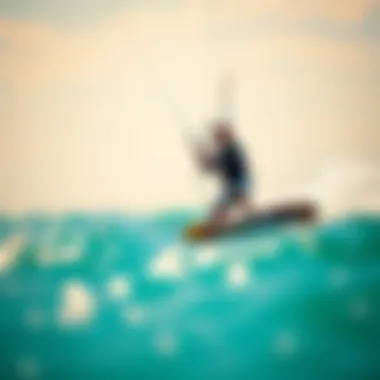
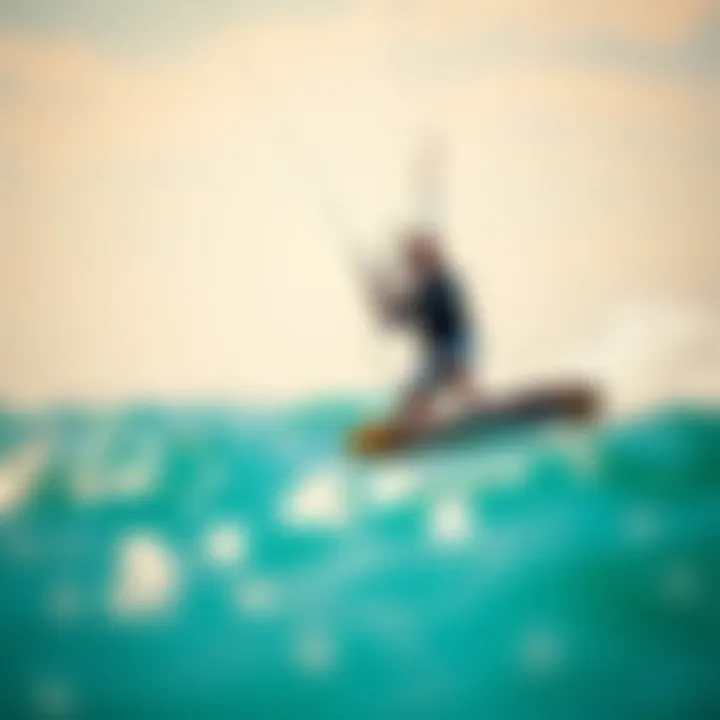
Wave Conditions
The next consideration should be the types of wave conditions you plan to ride in. Wave size, strength, and overall water dynamics can heavily influence your choice. For example, if you anticipate tackling high, powerful waves, a leash with a higher breaking strength is advisable. The unique feature of such leashes is their ability to withstand significant force, which is paramount in rough conditions.
In calmer, gentle waves, a lighter leash could suffice, providing enough performance without weighing you down. This adaptability in the leash allows kiteboarders to maximize their riding experience based on variable wave conditions, so understanding what’s typical for your chosen spot can pay dividends.
Popular Brands and Models
Comparison of Top Brands
When talking about brands, the market doesn’t disappoint. Well-known names such as Mystic, Naish, and Flysurfer are often cited for their high-quality coiled surf leashes. A key characteristic of these brands lies in their commitment to innovation and safety features, which come highly recommended for kiteboarding enthusiasts. By comparing these top brands, you will discover unique features such as increased durability or greater elasticity that set them apart.
For instance, Mystic leashes are often praised for their exceptional quick-release systems, making them a favorite among both beginners and pros. Naish leashes, on the other hand, may boast advanced material technology aimed at reducing drag, which can be a game changer for competitive riders. In terms of advantages, choosing a reputable brand instills confidence in the leash's quality; however, it’s crucial to evaluate user needs against the specific offerings of each brand.
User Reviews and Ratings
In the age of information, user reviews and ratings should not be overlooked. These insights offer a nuanced view into the performance and durability of coiled surf leashes in real-world scenarios. Riders often share experiences regarding comfort, flexibility, and any issues they’ve encountered over time.
The unique feature of user reviews is that they can highlight both shortcomings and strengths of a product in ways that marketing often doesn’t address. For instance, an overwhelmingly positive rating on a specific model may reveal its reliability in tough conditions or convenience in cleaning. On the flip side, negative feedback might expose unexpected vulnerabilities. This underscores the necessity of taking an informed approach by considering a chorus of rider experiences and opinions, allowing potential buyers to make a well-rounded, informed decision.
"The right leash not only secures you to your board, but it also can enhance your entire kiteboarding experience, making it a fundamental component of safety and performance."
In summary, choosing the right coiled surf leash involves careful consideration of your riding abilities, the conditions you’ll be facing, alongside informed comparisons of popular brands and user insights. The goal is for every kiteboarder—beginner or seasoned—to find a leash that enhances their ride while ensuring safety is never compromised.
Maintenance and Care for Your Leash
Taking care of your coiled surf leash is one of the most vital aspects of ensuring its longevity and effectiveness. Proper maintenance not only prolongs the lifespan of the leash but also plays a significant role in rider safety and performance. When you invest in a high-quality coiled leash, it's essential to implement a routine that keeps it in tip-top shape.
Cleaning Techniques
Basic Cleaning Routine
Establishing a simple yet effective cleaning routine for your coiled surf leash is crucial. After each session, rinse the leash with fresh water to remove salt and sand. This step helps maintain the materials and prevents degradation caused by lingering debris.
The key characteristic of this basic routine is its simplicity. Just a few minutes after your ride can significantly increase the lifespan of your gear. Rinsing prevents the buildup of salt crusts, which can damage the elastic and other components over time.
Moreover, you can give your leash a deeper scrub with a soft brush every few weeks, focusing on areas where grime tends to accumulate. This will ensure that your leash components remain free from corrosion and wear. While a more thorough cleaning might be seen as tedious, the benefits—extended life and reliability of your leash—are well worth the effort.
Avoiding Damage from Salt Water
Salt water can be quite the villain when it comes to gear maintenance. When it comes to your coiled leash, avoiding salt water damage is a pivotal part of your maintenance strategy. Salt crystals can gradually erode components, which might leave your leash vulnerable when you need it the most.
By rinsing your leash immediately after use, you're essentially giving it a protective shield against this corrosive element. This regular maintenance habit is beneficial not just for your leash but for your overall kiteboarding experience. Saltwater damage can often go unnoticed until it's too late, leading to potentially hazardous situations on the water.
To add to the challenge, not all leashes are resistant to salt damage equally. Some materials may degrade faster than others, making it imperative to understand your leash’s composition. Keeping your leash clean is an advantageous practice, but over time, regular exposure to saltwater might still necessitate replacing parts before they become a liability.
Storage Recommendations
Proper storage is as crucial as cleaning when it comes to maintaining your coiled surf leash. How you store your gear can dictate its usability and lifespan. Ensuring that your leash is stored correctly will prevent unnecessary wear from elements like UV rays and humidity.
Best Practices for Long-Term Storage
When storing your leash for an extended period, it's advisable to keep it in a cool, dry place, away from direct sunlight. Over time, UV radiation can weaken synthetic materials, leading to deterioration. A soft bag or a dedicated storage container is often a beneficial choice, as it protects the leash from environmental factors and maintains its flexibility.
Additionally, securing the leash without it being coiled too tightly can prevent creasing, which is a common point of failure in elastic materials. Avoiding this kind of damage can help your leash remain taut and responsive when the time comes to hit the waves again.
Preventing Wear and Tear

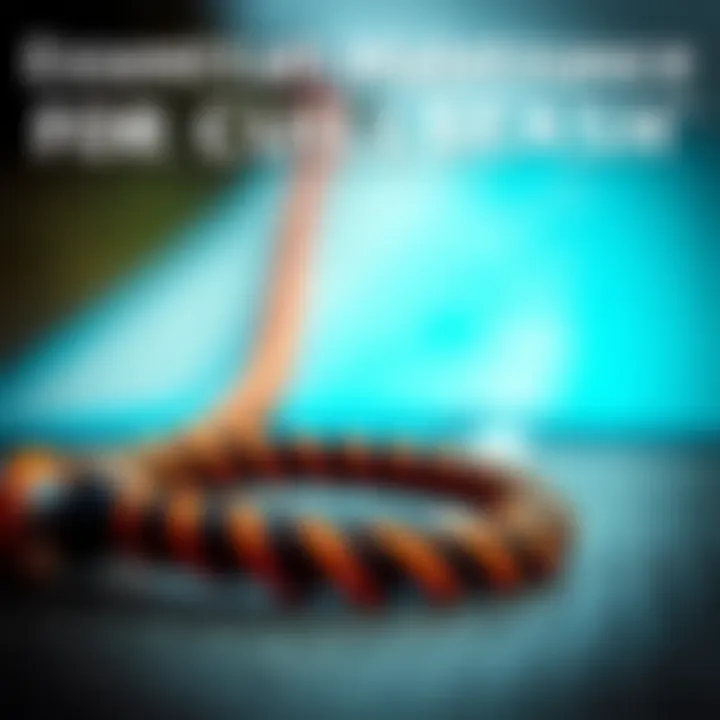
Preventing wear and tear on your coiled surf leash boils down to being mindful about how you use and handle it. Little practices, like avoiding dragging it across rough surfaces and ensuring it doesn’t twist excessively, can make a significant difference in durability.
The key aspect here is awareness. Understanding where and how you use your leash will directly impact its condition. For example, if you often ride in rocky areas, be particularly cautious to inspect your leash frequently for cuts or abrasions. Choosing to perform regular inspections is a valuable practice that can save you headaches down the line.
Investing time in both cleaning and storing your leash can contribute immensely to your overall kiteboarding experience. Recognizing that maintenance is a continuous endeavor can help you stay ahead of potential issues, keeping you safe and your gear in optimal condition.
"A little care can go a long way in protecting your leash, so don’t let it slip your mind!"
For additional tips and community insights, you can explore resources like Reddit or Wikipedia.
Market Trends and Innovations
The landscape of surf leashes is not static; it's continually evolving, mirroring advancements in materials, technology, and user needs. Understanding market trends and innovations in this arena provides valuable insights for Kiteboarders, instructors, and enthusiasts alike. In a world where functionality, sustainability, and performance are paramount, staying abreast of these developments is essential for both safety and an enhanced surfing experience.
Emerging Technologies
Smart Leashes
Smart leashes have arrived, integrating technology with functionality. These leashes often come equipped with GPS tracking, making it easier for riders to locate their boards when tossed by strong surf. Imagine being able to pinpoint exactly where you last saw your board, adding a layer of security that reduces anxiety, especially in unpredictable conditions. One key characteristic of smart leashes is their built-in Bluetooth connectivity, allowing real-time monitoring through mobile apps. While this feature boosts convenience, it can come with a trade-off; the added tech needs charging, and not every rider may find it necessary. For some, simplicity in equipment is favored. Still, for the tech-savvy kiteboarder, smart leashes present a revolutionary option worth considering.
Eco-Friendly Materials
As awareness of environmental issues grows, so too does the demand for eco-friendly materials in surf gear, including leashes. Manufacturers are incorporating bio-based plastics and recycled materials, aiming for sustainability without sacrificing performance. One of the standout characteristics of these eco-friendly options is their reduced environmental impact, making them a popular choice among conscious riders. However, the unique feature of such leashes often lies in their sourcing and production methods.
Adopting eco-friendly materials might not always offer the same durability as conventional leashes, but many riders are willing to make that compromise for a greener choice. In a market increasingly leaning towards sustainability, these materials can redefine consumer priorities, making them a choice not just for individual performance but for overall ecological impact.
Consumer Preferences
Trends in Design
With the evolution of surf leashes, design trends have started reflecting functionality and personal style. These trends are significant; they indicate consumer desires for more than just basic safety features. Key elements of design trends now include vibrant colors, unique patterns, and ergonomic fittings. Riders want leashes that not only perform well but also express their individuality. As surf leashes transition from merely functional gear to style statements, manufacturers are responding. However, some riders question whether aesthetic designs may impact performance or durability. These concerns highlight the critical balance brands must achieve between performance and visual appeal, catering to a diverse user base.
Shifts in Popularity
Finally, shifts in popularity reveal changing consumer attitudes that impact purchasing behaviors. Recent data suggests a growing preference for coiled leashes over traditional straight designs. Coiled leashes, praised for reducing drag and tangling, align with the current demand for efficiency and safety. What’s more, newcomers to the sport, often influenced by online trends and social media, gravitate towards what’s trending in the market. This shift indicates a generational change in how kiteboarders select their gear, demonstrating the significant role of community as well as market innovations in shaping personal preferences.
"Innovations in leashes not only enhance performance but also reflect our commitment towards a sustainable future."
In essence, the market for coiled surf leashes is witnessing exciting changes that blend technology with environmental consciousness, appealing to a wide range of riders. These trends and innovations are vital, providing a better understanding of what to look for, ensuring that all riders find the best fit for their style and needs.
Closure
The conclusion acts as the linchpin of this comprehensive guide, drawing together all the threads of information woven throughout the article on coiled surf leashes. It emphasizes the crucial role that these leashes play in kiteboarding, both as a safety apparatus and as a factor that enhances overall riding performance. Without a doubt, investing time and effort into understanding these intricate pieces of equipment ensures that riders are not just equipped but also empowered.
Summarizing the Importance of Coiled Leashes
Coiled leashes have not just become popular for their aesthetic appeal; they are fundamentally designed to solve many issues associated with traditional leashes. Here’s why they're important:
- Safety First: Coiled leashes significantly reduce the risk of tangling, which can lead to dangerous situations in the water. In chaotic surf conditions, having this assurance is invaluable.
- Performance Benefits: The elasticity of the coil offers a unique advantage by minimizing drag. This not only makes for a smoother ride but also enhances responsiveness when maneuvering.
- Durability vs. Wear: Given that coiled leashes often use high-quality materials, they tend to withstand the test of time better than their straight counterparts. This longevity is a financial as well as functional blessing for riders who frequent the waves.
- User-Friendly Features: Quick-release mechanisms have become a staple in modern coiled leashes. These features ensure that riders can detach swiftly in the event of an emergency, which can be a game-changer under pressure.
In sum, the importance of coiled leashes cannot be overstated; they're not just accessories but essential elements that can transform one’s experience on the water.
Future Outlook
As the kiteboarding industry evolves, so too does the technology surrounding surf leashes. The future holds exciting possibilities for coiled leashes, as manufacturers continuously seek to improve their design and functionality. Some key trends to watch are:
- Smart Technology: Imagine leashes equipped with sensors to monitor your activity or detect potential risks. Smart leashes could provide data feedback, enhancing both safety and performance metrics for riders.
- Eco-Friendly Options: The demand for sustainable products is growing. Manufacturers are exploring innovative, environmentally friendly materials that do not compromise performance while addressing ecological concerns. This shift reflects a broader trend toward conscientious consumerism in sporting goods.
- Customization and Personalization: Future leashes may offer customizable features, allowing enthusiasts to tailor them to their preferences or specific riding conditions. Brands are likely to experiment with colors, designs, and functionalities that allow personal expression on the water.
"An informed rider is a safer rider. Understanding your gear can make all the difference when you're out there in the waves."
The insights shared throughout this article aim to equip you with the knowledge necessary for selecting the ideal coiled surf leash, ensuring that your kiteboarding experience is both safe and exhilarating.
For further reading on kiteboarding trends and equipment, you may find articles on Wikipedia and Reddit to be particularly useful.






